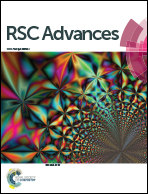Theoretical studies on the photoisomerization mechanism of osmium(ii) sulfoxide complexes†
Abstract
Photochromic compounds, employing photonic energy for excited-state bond rupture and bond construction processes, are excellent candidates for application as optical molecular information storage devices. In this work, a dispersion corrected density functional theory (DFT-D) study was carried out on the photoisomerization mechanism of the osmium sulfoxide complex, [Os(bpy)2(DMSO)2]2+ (bpy = 2,2′-bipyridine; DMSO = dimethyl sulfoxide), which features a pronounced photochromic character based on an ultrafast photo-triggered linkage isomerization located at the SO-ligand. Calculated results demonstrate that the Os–S → Os–O isomerization proceeds adiabatically on the potential energy surface (PES) of the lowest metal-to-ligand charge transfer excited states 3MLCTS → 3MLCTO, and the metal centered ligand field (3LFS) excited state is not involved. However, attributed to the weakened Os–DMSO bond-strength upon Os–S to Os–O isomerization, the population of the 3LFO excited state is thermally accessible. Therefore, photodissociation of DMSO from the Os center occurs via homolytic cleavage of the Os–O bond after an avoided curve crossing between the lowest 3MLCTO state and the 3LFO repulsive state along the stretching coordinate of the Os–O bond.


 Please wait while we load your content...
Please wait while we load your content...